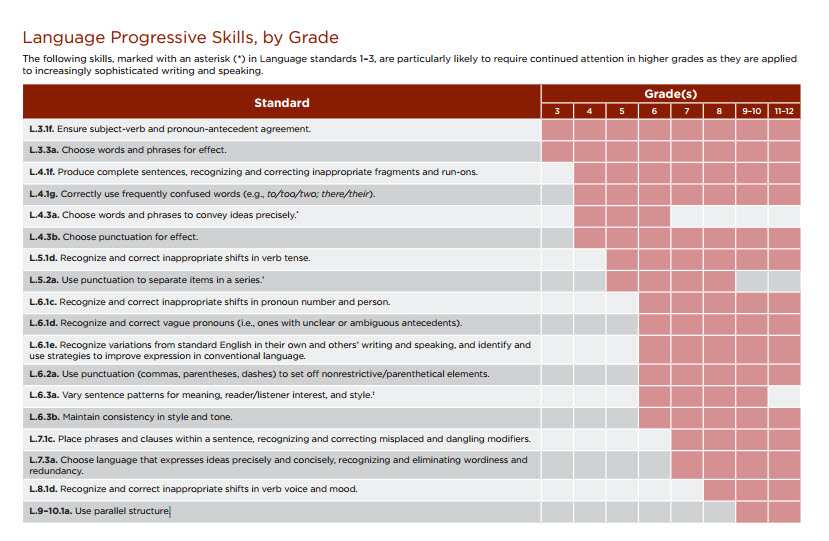At this point, we, the community at the Teaching the Core blog, have grappled with three of the four “strands” of Common Core anchor standards. Yippee!
L.CCR.1 — that's the 1st College and Career Readiness anchor standard within the Language strand of the Common Core State Standards (CCSS) for ELA/Literacy — says:
Demonstrate command of the conventions of standard English grammar and usage when writing or speaking.
It's interesting to note that L.CCR.1 is closely connected to the last anchor standard we examined, SL.CCR.6. However, there are definitely some key differences, and that's what we'll be examining in this post.
The intertwining nature of L.CCR.1-3
The first three anchor standards within the Language strand are pretty intertwined throughout the CCSS grade-specific standards. For the sake of seeing where we're heading, here's what those first three standards contain, at both a broad level and with a few examples to give you a more explicit picture:
- L.CCR.1 — Grammar and Usage
- Subject-verb agreement (L.3.1 — that is, the 1st standard within the Language strand for Grade 3)
- Pronoun-antecedent agreement (L.3.1)
- Avoid fragments and run-ons (L.4.1)
- Correctly use high-frequency homophones (L.4.1)
- Recognize and correct inappropriate shifts in verb tense (L.5.1)
- Recognize and correct inappropriate shifts in pronoun number and person (L.6.1)
- Recognize and correct vague pronouns/ambiguous antecedents (L.6.1)
- Recognize variations from standard English and improve expression in conventional language (L.6.1)
- Use phrases and clauses in a sentence (L.7.1)
- Recognize and correct misplaced or dangling modifiers (L.7.1)
- Recognize and correct inappropriate shifts in verb voice and mood (L.8.1)
- Use parallel structure (L.9-10.1)
- L.CCR.2 — Mechanics and Spelling
- Use punctuation to separate items in a series (L.5.2)
- Use punctuation (commas, parentheses, dashes) to set off nonrestrictive elements (L.6.2)
- L.CCR.3 — Meaning and Style
- Choose words and phrases for effect (L.3.3)
- Choose words and phrases to convey ideas precisely (L.4.3)
- Choose punctuation for effect (L.4.3)
- Vary sentence patterns for meaning, reader/listener interest, and style (L.6.3)
- Maintain consistency in style and tone (L.6.3)
- Recognize and eliminate wordiness, awkwardness, and redundancy (L.7.3)
All of the above examples were taken from the “Language Progressive Skills” chart, pictured below:
It's important to note that these aren't all of the language skills specified in the grade-specific standards of the Language strand; rather, these are the ones that will require continued attention in subsequent grades.
Grammar and usage: the focus of L.CCR.1
And that brings us to our first standard. Unlike most of the anchor standards we've looked at, the grade-specific standards are really crucial here. Within them, you'll find the specific aspects of grammar and usage that you're expected to help students with.
But wait! Grammar is terrible!
This is the sentiment of many a teacher, including many an English teacher! However, if we shirk grammar instruction, we withhold a crucial tool from our students. (Click to tweet this.)
In other words, even though you might, like me, dislike explicit grammar instruction, we've got to do it if we love our students.
On that note, I think the balanced approach to such instruction outlined in Judith Langer's Effective Literacy Instruction (2002) is a great framework.
A balanced approach to grammar instruction
To get today's comment conversation kicked off, I'd like to share a Prezi I made two summers ago for my demo at a National Writing Project Summer Institute. The demonstration discusses a “balanced approach” to teaching grammar. Such an approach teaches grammar in isolated, simulated, and integrated scenarios.

Leave a Reply